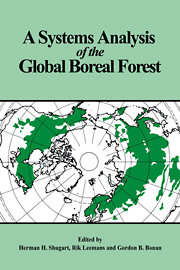Book contents
- Frontmatter
- Contents
- List of contributors
- 1 Introduction
- Part 1 Processes in boreal forests
- Introduction
- 2 Silvics of the circumpolar boreal forest tree species
- 3 The reproductive process in boreal forest trees
- 4 Soil temperature as an ecological factor in boreal forests
- 5 Fire as a controlling process in the North American boreal forest
- 6 The role of forest insects in structuring the boreal landscape
- Part 2 Patterns in space and time in boreal forests
- Part 3 Computer models for synthesis of pattern and process in the boreal forest
- References
- Index
Introduction
Published online by Cambridge University Press: 12 January 2010
- Frontmatter
- Contents
- List of contributors
- 1 Introduction
- Part 1 Processes in boreal forests
- Introduction
- 2 Silvics of the circumpolar boreal forest tree species
- 3 The reproductive process in boreal forest trees
- 4 Soil temperature as an ecological factor in boreal forests
- 5 Fire as a controlling process in the North American boreal forest
- 6 The role of forest insects in structuring the boreal landscape
- Part 2 Patterns in space and time in boreal forests
- Part 3 Computer models for synthesis of pattern and process in the boreal forest
- References
- Index
Summary
Introduction
The boreal forest environment is characterized by a wide range of site conditions. Climatic conditions range from extremely cold, dry continental regimes in interior Alaska and Siberia to warmer, moist, oceanic regimes in eastern Canada and Fennoscandinavia (Hare & Hay 1974). Extreme temperatures as low as −70°C are not uncommon in interior Alaska and Siberia (Rumney 1968). In more moderate regions such as Saint John, Canada, extreme lows average −23°C (Hare & Hay 1974). Annual precipitation can be as little as 10–20 cm in the dry continental regions of interior Alaska and Siberia, but as much as 50–90 cm in eastern Canada (Rumney 1968). Annual global solar radiation varies from less than 3352 MJ m−2 at the tree-line in western Canada to over 5028 MJ m−2 in the south (Hare & Hay 1974). Maximum day length varies from 16 hours at the southern edge of the boreal forest to 24 hours at the northern tree-line (Hare & Hay 1974).
In North America, soil moisture ranges from xeric jack pine (Pinus banksiana Lamb.) and black spruce (Picea mariana (Mill.) B.S.P.) forests to lowland black spruce and tamarack (Larix laricina (Du Roi) K. Koch) bogs (Larsen 1980). Soil temperature ranges from widespread warm, permafrost-free soils to scattered permafrost soils in interior Alaska and western Canada to extensive cold, permafrost soils in central and eastern Siberia (Larsen 1980). Local soil temperature gradients can be large. In the discontinuous permafrost zone of interior Alaska, growing season soil temperature sums above 0°C range from as low as 483 in wet, permafrost soils to as high as 2217 in dry, permafrost-free soils (Viereck et al. 1983).
- Type
- Chapter
- Information
- A Systems Analysis of the Global Boreal Forest , pp. 9 - 12Publisher: Cambridge University PressPrint publication year: 1992
- 1
- Cited by



